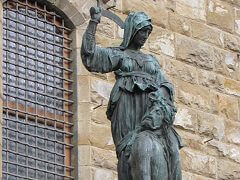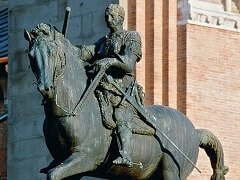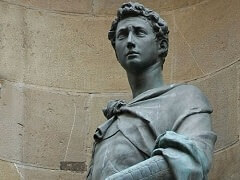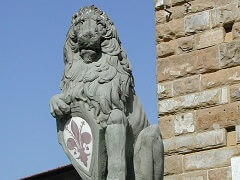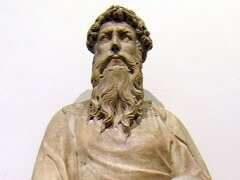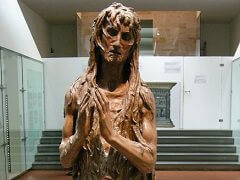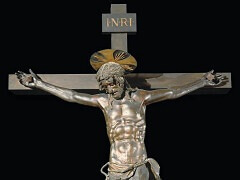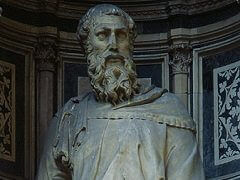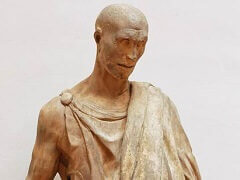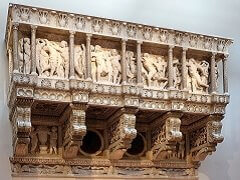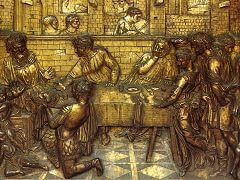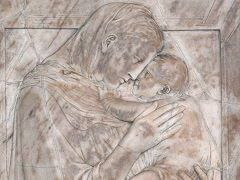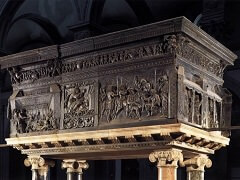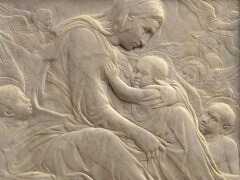Donatello Chronology
1386
Probable date of birth in Florence, son of Niccolo di Betto Bardi, wool-carder. (Calculated from tax declarations in 1427, when he claimed to be 40, and in 1433, when he claimed to be 47.)
1401
Pistoia, where he had struck a German with a stick and drawn blood.
1402-1404
According to Vasari, first visit to Rome with Brunelleschi, who had just lost the competition over the bronze doors for the Baptistery in Florence to Ghiberti.
1404-1407
Working in Ghiberti's shop on the modeling stages for his first set of doors. 1406 Payment is received for "marble prophets," designed for Porta della Mandorla, Florence cathedral.
1408
Commissioned to carve a David to go on a buttress of Florence cathedral; completed in 1409. Commissioned to carve St. John the Evangelist for the west front of the cathedral (finished 1415).
1410-1412
Payments received for a terracotta colossal statue of Joshua for a buttress of the cathedral.
1411
The Linen Drapers' Guild commissions the St. Mark for their niche on Orsanmichele (finished 1413).
1412
Matriculates in the Guild of St. Luke as a "goldsmith and stone-carver."
1415
Paid with Brunelleschi for a "small figure of stone, clad in gilt lead," which served as a model for further figures to go on the buttresses.
1415
December: two marble statues of prophets for the Campanile are commissioned (finished 1418 and 1420 respectively).
1416
The city council (Signoria) acquires from the Board of Works of Florence cathedral a marble David for installation in the city hall (Palazzo della Signoria): it was to be elaborately painted and gilded, with a base
inset with mosaic.
1417
The Guild of Armorers buys a block of marble for the base of their St. George on Orsanmichele, possibly for carving the shallow relief of St. George and the t Dragon: in any case, the document tends to imply that the statue
was finished.
1418
Carves the heraldic lion of Florence (Marzocco) for the newel post of a stairway in the new papal apartments in the Monastery of Santa Maria Novella (finished 1420). Probably began the gilt-bronze St. Louis for the niche
of the Guelph Party on Orsanmichele.
1418-1419
With Brunelleschi and Nanni di Banco produces a model in brick and cement for the dome of Florence cathedral.
1421
Carves with Nanni di Bartolo the group of Abraham and Isaac for the Campanile.
1421-1426
Rents a house from the Frescobaldi next to their palace.
1422
Completion of the niche for St. Louis on Orsanmichele in Florence. Receives payment for reliefs of "two heads of prophets" on the Porta della Mandorla.
Discussions over nature and location of the tomb of the antipope John XXIII in the Baptistery.
1423
Receives payment for a statue for the Campanile, probably Jeremiah. Commissioned by the Board of Works of Orvieto cathedral to make a gilt-bronze statuette of St. John the Baptist for the font (not identified). Commissioned
by Siena cathedral to manufacture a bronze relief of the Feast of Herod for the font (finished by 1425, delivered 1427).
1425-1426
Goes into partnership with Michelozzo di Bartolommeo, probably in connection with a commission for the tomb of the antipope John XXIII in the baptistery (completed about 1428). The partnership lasts until about 1433.
Donatello's workshop is now in Corso degli Adimari, south of the cathedral. Payments from the Medici branch bank prove that Donatello was in Pisa, probably acquiring marble from the nearby quarries of Carrara, for the
tombs of John XXIII and Cardinal Brancacci for Naples.
1426
Documented contact with Masaccio, who was also working in Pisa. Probable date of certain shallow reliefs (e.g., the Assumption for Naples and the oval Virgin and Child). A statue for the Campanile, probably Jeremiah,
is finished.
1427
Receives payment for another statue for the Campanile, probably Hahbakuk. Date on the signed bronze tomb slab for Bishop Giovanni Pecci in Siena cathedral. First tax return (Portata al Catasto) of the partners, written out
by Michelozzo, declares work on the gilt-bronze San Rossore for the convent of Ognissanti in Florence; tomb of John XXIII three-quarters complete; tomb of Cardinal Brancacci one-quarter complete; Aragazzi monument for
Montepulciano in hand; marble figure, probably Habbakuk, three-quarters complete.
1428
Receives payment for the two bronze statuettes Faith and Hope for the Siena font. Contract for the exterior pulpit on Prato cathedral (finished 1438).
1429
Models three putti for the Siena font. 1430 Engages with Brunelleschi on military preparations outside Lucca. Goes to Rome with Michelozzo.
1432
Executes the tomb slab for Giovanni Crivelli, archdeacon of Aquileia (in Santa Maria in Aracoeli).
Executes the Tabernacle of the Blessed Sacrament for St. Peter's. Letter between the Medici and Prato authorities about persuading him to return from Rome and finish the pulpit; Pagno di Lapo, his assistant, is sent to Rome
to fetch him.
1433
Submits his tax return. The Medici rent him the former inn of Santa Caterina for working premises (until 1443).
Models the reliefs in the Old Sacristy of San Lorenzo.
The Singing Gallery for Florence cathedral commissioned and marble obtained.
The bronze capital for the Prato pulpit is begun; carving of the marble panels continues until 1438.
1434
His design for a stained glass window in the cathedral showing the Coronation of the Virgin is chosen instead of Ghiberti's (finished by 1437). He and Luca della Robbia each make a model in terracotta for a colossal head
for the top of the dome in Florence cathedral.
Bronze door for the tabernacle on Siena font is rejected by the Sienese.
1435
Date of execution of the Cavalcanti Annunciation.
1436
Habbakuk is finished and paid for.
1437
Bronze doors for sacristy of Florence cathedral are commissioned though never executed by Donatello.
1438
Date inscribed on the painted wood St. John the Baptist in the church of the Frari, Venice. Prato pulpit finished.
1439
Makes a wax model for an altar of St. Paul in Florence cathedral, to be carved in marble by Luca della Robbia. Bronze heads cast and gilded, to go beneath his Singing Gallery, which was thus completed.
1443
Buys a house at Figline near Prato. Moves to Padua.
1444
Starts work on the bronze Crucifix (finished 1449).
1445
Briefly returns to Florence, estimating with Luca della Robbia II Buggiano's Lavabo in the cathedral sacristy. Commission for the bronze doors is transferred to Michelozzo and Luca della Robbia.
1446
Bequest of Francesco Tergola for the high altar of the Basilica of St. Anthony, Padua; Donatello assembles his team of craftsmen.
1447
Panels of Angels, Evangelists and Miracles of St. Anthony are modelled, cast and chased. St. Louis and St. Francis begun. Monument to Gattamelata commissioned (finished 1453).
1448
All the Saints and the Virgin and Child cast. Temporary altar in wood erected to demonstrate the appearance for the feast of St. Anthony (13 June). Marble altar then begun.
1449
Entombment relief paid for. Pieta relief produced. 1450 The statues definitively installed on the high altar. Legal proceedings against Petruccio, over a lapsed commission for a chapel. Seven items sent to Mantua for
Lodovico Gonzaga and Barbara of Brandenburg. Negotiations over a statue of Borso d'Este for Modena (not finished).
1451
Payment from the Bishop of Ferrara; further work for Modena; correspondence with Lodovico Gonzaga about a casket of St. Anselm (never executed).
1452
Alfonso of Aragon, King of Naples, writes to the Venetian government in an attempt to obtain Donatello's services.
1453
Valuation of the Monument to Gattamelata.
1454
Rents a house and shop on Piazza del Duomo in Florence.
1455
Possible date of execution of the St. Mary Magdalene. Dispute with Prato authorities over payment outstanding on the pulpit.
1456
Gives bronze roundel of the Virgin and Child to his doctor, Giovanni Chellini, in lieu of a medical fee for attendance during a protracted illness. Purchases materials for casting bronze statuary. Bartolomeo Bellano from
Padua is an assistant. Begins work for the Board of Works of Siena Cathedral, possibly on the bronze St. John the Baptist for the Baptistery.
1457
Moves to Siena; is paid for St. John; to work on the chapel of Nostra Donna della Grazie (previously allocated to Urbano da Cortona). Begins wax models for the west doors of Siena cathedral - work continues until 1459.
1458
Lodovico Gonzaga tries in vain to obtain Donatello's services from the Sienese.
1459
Returns to Florence, renting a house on "via del Cocomero" (via Ricasoli today).
Probably produces Judith and Holofernes and bronze Pulpits in San Lorenzo for the Medici.
1461
Paid for work on the Chapel of the Annunziata in that church by Piero de' Medici.
1464
Death of Cosimo de' Medici;
1465
15 June, date on the relief of the Martyrdom of San Lorenzo on the North Pulpit of San Lorenzo.
1466
10/13 December, dies, leaving Pulpits unfinished. Buried ceremoniously, near Cosimo de' Medici, in the crypt of San Lorenzo.


